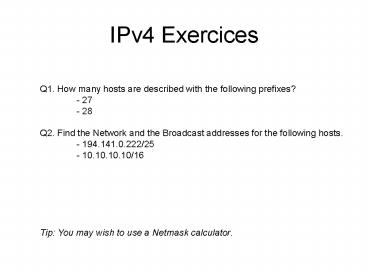IPv4 Exercices - PowerPoint PPT Presentation
Title: IPv4 Exercices
1
IPv4 Exercices
Q1. How many hosts are described with the
following prefixes? - 27 - 28 Q2. Find the
Network and the Broadcast addresses for the
following hosts. - 194.141.0.222/25 -
10.10.10.10/16 Tip You may wish to use a
Netmask calculator.
2
IPv6 Exercices
Q1. How many hosts are described with the
following prefixes? - 100 - 48 Q2. Calculate
the range of IPv6 addresses for -
20014b5827/48 - 10.10.10.10/16
You may try to solve the task again with some
help from http//www.tdoi.org
3
IPv4
T1. Set the following aliases to your ethernet
adapter - Left group 10.0.0.x/26 - Right
group 192.168.0.y/27 T2. Try to ping your
neighbors, for ex. ping 10.0.0.5. You will not
be able to ping the IPs of the neighbor
group. T3. Set the following aliases to your
ethernet adapter - Right group 10.0.0.x/26 -
Left group 192.168.0.y/27 T4. Try to ping your
neighbors, for ex. See T2. You are able to ping
the IPs of the neighbor group.
Attention x and y must be unique in this class
4
IPv6
T1. Set an IPv6 address to your ethernet adapter.
Use 125 for prefix. T2. Trace the route to
www.6diss.org via both IPv6 and IPv4 Use the
following machine studentSofia011_at_hp.uni-plovdiv
.bg Help ipv6 install netsh interface
ipv6 add address if_name" IPv6_address netsh
interface ipv6 add route /0 " if_name "
nexthopIPv6_address publishyes
5
Hands on
T1. Find out for the both TCP and UDP protocols
the following - listen ports on your local
PC - established TCP connections on your local
PC T2. Same as T1 but for studentSofia011_at_hp.uni
-plovdiv.bg T3. Figure out the local opened TCP
port (on your machine) due to the ssh session
hp.uni-plovdiv.bg (from T2). You may need
some help For T1 Use Windows Command Prompt and
the command netstat For T2 PuTTY may be useful
for this task































